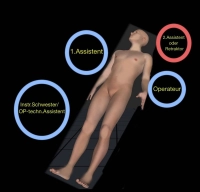1. Asymptomatic carotid stenosis
Stenosis is classified as asymptomatic if there have been no stenosis-associated symptoms within the prior six months.
According to current guidelines, surgical desobliteration in asymptomatic carotid stenosis of least 60% may be recommended, provided that the perioperative risk of stroke is <3%. Moreover, patients should have a life expectancy of more than 5 years.
In asymptomatic carotid stenosis, patients with the following particular risk factors benefit from invasive treatment:
- Progressive stenosis under optimized medication including smoking cessation
- Occlusion of the contralateral internal carotid artery
- Contralateral symptomatic stenosis and ipsilateral high-grade asymptomatic stenosis
- Statin intolerance
- Adverse morphology of the carotid plaque, e.g., floating thrombi or ulcers
- Bleeding into plaque on MRI
- Microembolism in transcranial Doppler ultrasonography
- Silent infarction on CT or MR imaging
- Reduced cerebrovascular reserve
2. Symptomatic carotid stenosis
Symptomatic carotid stenosis with luminal narrowing of 50% or more should undergo surgery, with a perioperative risk of stroke of <6%.
Timing
- In TIA or non-disabling stroke, if possible within the first 2 weeks (ruptured plaque with increased rate of re-embolization and increased risk of stroke)
- In crescendo TIA (recurrent carotid-associated TIAs in ever shorter intervals) as emergent surgery for secondary prevention
- In stable patients with regressive neurological symptoms of manifest stroke as early as possible; preoperative MRI detection of impaired intracranial barrier and progressive bleeding mandatory; interdisciplinary indication!
Carotid stenosis staging
| Stage I: | Asymptomatic stenosis |
| IA | No high-grade contralateral stenosis/occlusion |
| IB | High-grade contralateral stenosis/occlusion |
| Stage II: | Reversible cerebral ischemia (<6 months) |
| IIA | Amaurosis fugax |
| IIB | Transient ischemic attack (TIA) (symptoms <24 h) |
| Stage III | Ischemic stroke >24 h with clinical restitution |
| IIIA | Crescendo TIA |
| IIIB | Acute/progressive stroke |
| Stage IV | Ipsilateral stroke < 6 months |
| Rankin 0 | No symptoms at all |
| Rankin 1 | No significant disability despite symptoms; able to carry out all usual duties and activities |
| Rankin 2 | Slight disability; unable to carry out all previous activities, but able to look after own affairs without assistance |
| Rankin 3 | Moderate disability; requiring some help, but able to walk without assistance |
| Rankin 4 | Moderately severe disability; unable to walk without assistance and unable to attend to own bodily needs without assistance |
| Rankin 5 | Severe disability; bedridden, incontinent and requiring constant nursing care and attention |


